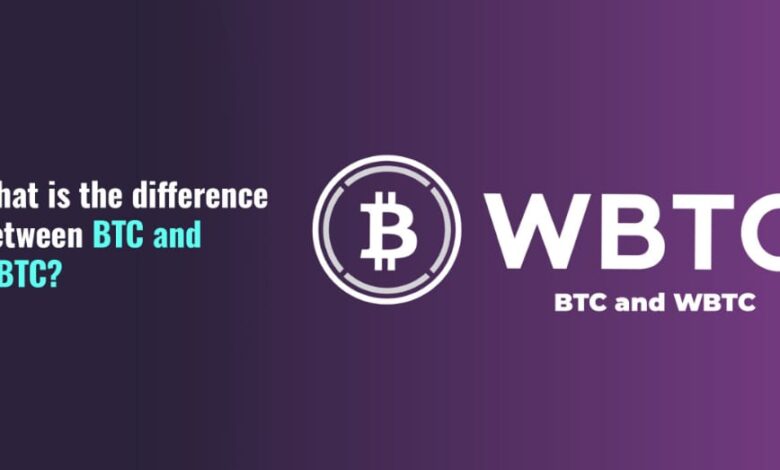What is the difference between BTC and WBTC?

Wrapped cryptocurrencies make it possible to use crypto assets on blockchains where they aren’t native. Bitcoin and other prominent cryptocurrencies have been added to smart contract platforms, including the Ethereum ecosystem, as a result of this interoperability hack. Wrapped coins, as a result, improve the utility and liquidity of smart contract developer and popular decentralized finance apps.
DeFi Interoperability and Wrapped Cryptos
In the cryptocurrency sector, interoperability, or the ability of multiple blockchain protocols to communicate and exchange value with one another, has long been a priority. However, with the emergence of Ethereum’s decentralized finance (DeFi) movement, the need for interoperability solutions has grown even more important, since the community demands that non-Ethereum-based assets be used in DeFi protocols.
Wrapped cryptocurrencies – tokens that are 1:1 replicas of other crypto assets, such as bitcoin — are one developing answer to such DeFi-related interoperability issues. Wrapped cryptocurrencies keep track of the value of the asset they represent and are frequently redeemable for it. They are often ERC-20 tokens or other smart contract platform tokens. As a result, they may be utilized inside the ecosystem of a smart contract platform (like Ethereum) and traded for other tokens within the ecosystem.
Wrapped cryptocurrencies, in brief, make it possible to utilize crypto assets on non-native blockchains. By tokenizing bitcoin as an ERC-20 token, the Ethereum ecosystem may benefit more fully from bitcoin’s liquidity.
What is WBTC?
Wrapped Bitcoin, or WBTC, is a simple ERC20 token that represents Bitcoin. A WBTC is the same as a BTC. WBTC and BTC may be exchanged back and forth. WBTC transfers quicker than regular Bitcoin since it is an ERC20 token, but its main benefit is its integration with Ethereum wallets, dapps, and smart contracts. There are about 900 WBTC in circulation right now. More on Forex Brokers
Who Was the Inventor of WBTC?
Wrapped BTC debuted on the Ethereum mainnet in January of this year. Wrapped Bitcoin was created as a joint initiative involving significant participants in the DeFi ecosystem, including BitGo, Ren, Dharma, Kyber, Compound, MakerDAO, and Set Protocol, with the goal of bringing additional liquidity to the Ethereum network through Bitcoin. The WBTC DAO, a Decentralized Autonomous Organization (DAO), is currently in charge of the project.
What makes it so unique?
Collateral is required by several of Ethereum’s most popular DeFi dapps. To borrow other crypto assets, products like MakerDAO and Compound need users to lock up their crypto assets. Because Ethereum’s overall value is considerably lower than Bitcoin’s, the growth potential of these protocols is limited. Protocols gain greater liquidity by transferring Bitcoin across, allowing them to provide more collateral for their dapps. Wrapped Bitcoin also allows Bitcoin holders to maintain their currency as an asset while borrowing or lending the money using DeFI dapps like Compound.
Wrapped Bitcoin Vs Bitcoin
There are a number of tokenized representations of bitcoin available. Bitgo, Kyber, and Ren collaborated to produce Wrapped Bitcoin (wBTC or WBTC), which was introduced in 2019. You must first request wBTC from a merchant, such as Kyber, DeversiFi, or Airswap, who will then conduct Know-Your-Customer (KYC) and Anti-Money Laundering (AML) checks to authenticate your identity. After that, the merchant begins a transaction with a custodian, who mints and delivers wBTC tokens to the merchant. Then, via a centralized exchange, decentralized exchange, or atomic swap, you trade your bitcoin for wBTC with the merchant. Only merchants can exchange wBTC for BTC.
Exchange of cryptocurrencies Huobi Global released Huobi BTC (hBTC), its own form of wrapped bitcoin, in 2020. One BTC underpins each HBTC. You may get hBTC by depositing BTC first and then withdrawing HBTC from your Huobi Global exchange account. By depositing hBTC into your account and withdrawing BTC, you may redeem your BTC. This method differs from wBTC, which, as previously stated, can only be redeemed by merchants. Both wBTC and hBTC, on the other hand, are very centralized techniques for wrapping bitcoin.
RenBTC, which was established in 2020, is a more decentralized alternative to wBTC and hBTC. To get renBTC, transfer bitcoin to Ren’s protocol, which will encrypt it and store it in a smart contract. The protocol then checks the transaction’s data and issues a minting signature, allowing you to create renBTC, an ERC-20 token that represents bitcoin. Ren also allows you to burn your renBTC to get your bitcoin back.
What else stands out?
Because there is still a divide between Bitcoin and Ethereum (the chains cannot communicate natively), individuals must be trusted. Wrapped BTC can never have the same level of security or trustworthiness as BTC since it manages the system through people and organizations rather than pure code.
WBTC conducts frequent audits and publishes all on-chain transactions and verifications for the Bitcoin and Ethereum networks to improve confidence and transparency. Users may check if the amount of BTC transferred to the WBTC address on the Bitcoin blockchain matches the generation of WBTC tokens on the Ethereum blockchain. On-chain tracking of the reverse process of burning WBTC to redeem BTC is also possible.
What is the process of creating WBTC tokens?
The WBTC DAO’s governing members decide on significant protocol updates and modifications, as well as who can assume the positions of Merchants and Custodians who run the system.
Merchants must engage with users who have BTC and wish to convert it to WBTC. Merchants begin the process of minting or destroying WBTC tokens by confirming users’ identities through verification processes. Custodians keep track of the real bitcoins being wrapped and mint and burn tokens on the Ethereum network. When WBTC is burnt, the user receives BTC back from the custodian. When a fresh WBTC is created, the custodian takes BTC from the user and stores it.
Wrapping up
It’s not about how consumers utilize WBTC in the future; it’s about what developers construct using WBTC. WBTC is a permission-less ERC20 coin that may be used to create DeFi apps. TokenSets, which has built products that automatically trade between WBTC and ETH to capture profits in both assets–combining the best of both worlds–is the finest illustration of how WBTC is becoming another DeFi building piece. Blockchain education is needed to get a grasp of things related to the development in blockchain technology. Best blockchain courses are available to get started with.



